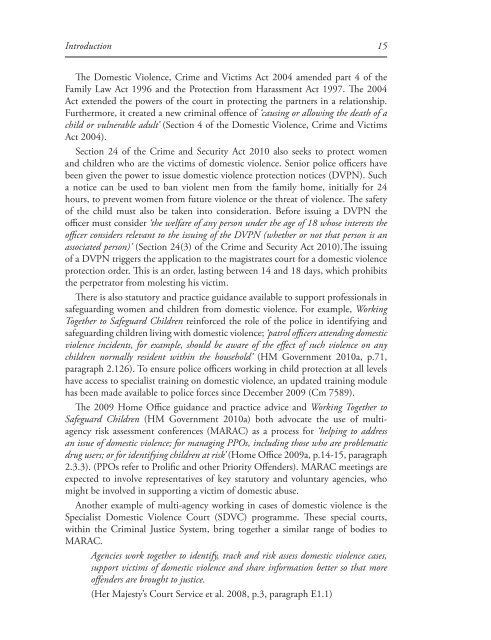Children's Needs â Parenting Capacity - Digital Education Resource ...
Children's Needs â Parenting Capacity - Digital Education Resource ...
Children's Needs â Parenting Capacity - Digital Education Resource ...
You also want an ePaper? Increase the reach of your titles
YUMPU automatically turns print PDFs into web optimized ePapers that Google loves.
Introduction 15The Domestic Violence, Crime and Victims Act 2004 amended part 4 of theFamily Law Act 1996 and the Protection from Harassment Act 1997. The 2004Act extended the powers of the court in protecting the partners in a relationship.Furthermore, it created a new criminal offence of ‘causing or allowing the death of achild or vulnerable adult’ (Section 4 of the Domestic Violence, Crime and VictimsAct 2004).Section 24 of the Crime and Security Act 2010 also seeks to protect womenand children who are the victims of domestic violence. Senior police officers havebeen given the power to issue domestic violence protection notices (DVPN). Sucha notice can be used to ban violent men from the family home, initially for 24hours, to prevent women from future violence or the threat of violence. The safetyof the child must also be taken into consideration. Before issuing a DVPN theofficer must consider ‘the welfare of any person under the age of 18 whose interests theofficer considers relevant to the issuing of the DVPN (whether or not that person is anassociated person)’ (Section 24(3) of the Crime and Security Act 2010).The issuingof a DVPN triggers the application to the magistrates court for a domestic violenceprotection order. This is an order, lasting between 14 and 18 days, which prohibitsthe perpetrator from molesting his victim.There is also statutory and practice guidance available to support professionals insafeguarding women and children from domestic violence. For example, WorkingTogether to Safeguard Children reinforced the role of the police in identifying andsafeguarding children living with domestic violence; ‘patrol officers attending domesticviolence incidents, for example, should be aware of the effect of such violence on anychildren normally resident within the household’ (HM Government 2010a, p.71,paragraph 2.126). To ensure police officers working in child protection at all levelshave access to specialist training on domestic violence, an updated training modulehas been made available to police forces since December 2009 (Cm 7589).The 2009 Home Office guidance and practice advice and Working Together toSafeguard Children (HM Government 2010a) both advocate the use of multiagencyrisk assessment conferences (MARAC) as a process for ‘helping to addressan issue of domestic violence; for managing PPOs, including those who are problematicdrug users; or for identifying children at risk’ (Home Office 2009a, p.14-15, paragraph2.3.3). (PPOs refer to Prolific and other Priority Offenders). MARAC meetings areexpected to involve representatives of key statutory and voluntary agencies, whomight be involved in supporting a victim of domestic abuse.Another example of multi-agency working in cases of domestic violence is theSpecialist Domestic Violence Court (SDVC) programme. These special courts,within the Criminal Justice System, bring together a similar range of bodies toMARAC.Agencies work together to identify, track and risk assess domestic violence cases,support victims of domestic violence and share information better so that moreoffenders are brought to justice.(Her Majesty’s Court Service et al. 2008, p.3, paragraph E1.1)
















